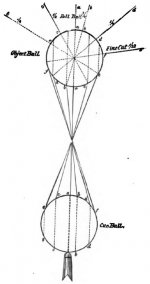What do you aim at in pool? Do you aim at the object ball, the pocket, the cue ball, the shadows, the lights? What is your primary target?
Remember an important, and often over-looked fact - the cue ball is always the primary target because it's the only thing we physically contact - we don't effect the object ball, or the pocket directly.
This is true no matter the distance, the speed, the spin, the angle, etc. Another reason "there are no easy shots or hard shots," because the target is actually where the tip connects to the cue ball at impact. If we don't hit the cue ball where we're aiming, it's not possible to hit the object ball as planned.
The object ball acts as a "mirrored" reflection of now we influence the cue ball. When we put left spin on the cue ball, it puts right spin on the object ball, when we put under-spin on the cue ball, it puts over-spin on the object ball etc.The cue ball is always the target and in every case we have to hit the cue ball precisely where we're aiming.
We're really not "aiming" at the object ball, we align to it in such a way that, when we hit the cue ball where we intend, the object ball (as a result) goes where we desire (in the final target which is the pocket or area of the table for a safety).
Remember an important, and often over-looked fact - the cue ball is always the primary target because it's the only thing we physically contact - we don't effect the object ball, or the pocket directly.
This is true no matter the distance, the speed, the spin, the angle, etc. Another reason "there are no easy shots or hard shots," because the target is actually where the tip connects to the cue ball at impact. If we don't hit the cue ball where we're aiming, it's not possible to hit the object ball as planned.
The object ball acts as a "mirrored" reflection of now we influence the cue ball. When we put left spin on the cue ball, it puts right spin on the object ball, when we put under-spin on the cue ball, it puts over-spin on the object ball etc.The cue ball is always the target and in every case we have to hit the cue ball precisely where we're aiming.
We're really not "aiming" at the object ball, we align to it in such a way that, when we hit the cue ball where we intend, the object ball (as a result) goes where we desire (in the final target which is the pocket or area of the table for a safety).


